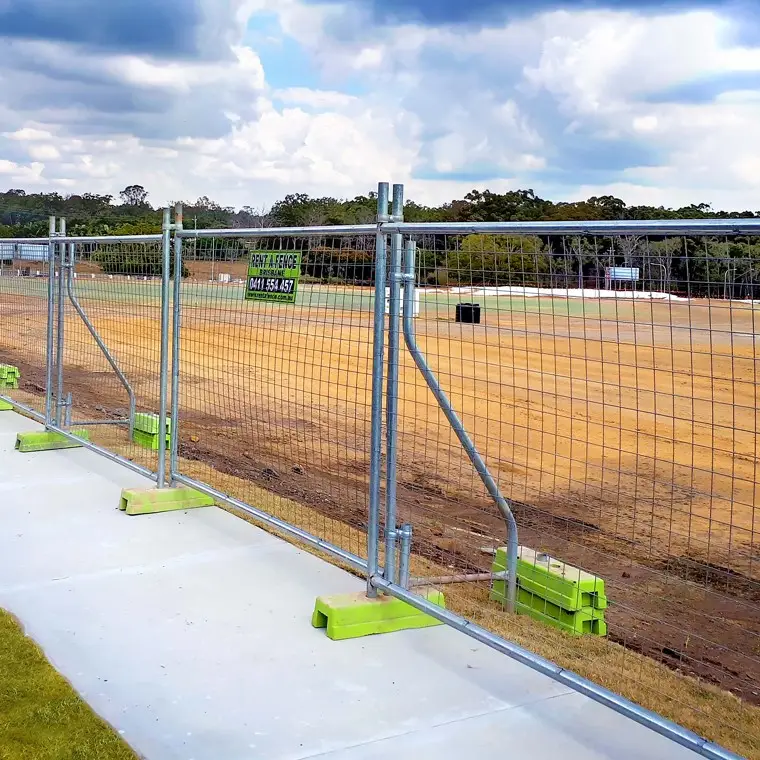When you’re launching a new project in Australia, the focus is often on the big picture: timelines, budgets, and the final result. Yet, some of the smallest details can have the biggest impact on your success. One of those critical details is temporary fencing. It’s more than just a simple barrier; it’s a legal requirement that ensures public safety, secures your assets, and protects your project from the significant risks of costly fines and work stoppages.
At Rentafence, we believe an informed client is a successful one. That’s why we’ve put together this comprehensive guide to help you navigate the essential laws and regulations, ensuring your site is safe, secure, and fully compliant from day one.
The Gold Standard: Understanding Australian Standard AS 4687-2022
The foundational document for all temporary fencing in Australia is Australian Standard AS 4687-2022. Think of this as the official rulebook that sets the minimum benchmark for quality and safety. It was updated in 2022 to reflect the latest safety requirements, so partnering with a supplier who is up-to-date is crucial.
This standard isn’t just about the panels themselves; it’s about the entire fencing system and its performance in real-world conditions. It mandates specific requirements for:
- Strength and Durability: Your fence must be robust enough to withstand the daily rigors of a worksite and powerful environmental forces like strong winds. A flimsy fence is a hazard waiting to happen.
- Stability and Installation: The standard dictates how a fence must be erected to remain stable. This includes the design of the fence feet, clamps, and overall height to prevent tipping or collapse.
- Mandatory Anchoring and Bracing: In areas prone to high winds or on long, exposed fence lines, secure bracing and anchoring are not just a good idea—they are a mandatory part of compliance to prevent the fence from becoming a dangerous projectile.
Meeting this standard is your first and most important step to ensuring your site is safe and avoiding any potential legal issues or project delays.
Construction Sites: A Non-Negotiable Requirement for Safety
For construction and civil sites, the question isn’t if you need a fence, but how quickly you can get a compliant one installed. Under Australia’s stringent Work Health and Safety (WHS) laws, every active worksite must be securely fenced off from public access. This is a core part of your “duty of care” as a site manager.
The goals of this regulation are crystal clear:
- Prevent Public Access: It’s essential to protect the public, especially curious children, from the numerous hazards on a worksite, such as deep excavations, heavy machinery, and falling objects.
- Secure the Site: A strong fence helps prevent theft and vandalism, protecting your valuable materials and equipment.
- Ensure WHS Compliance: Fencing is a fundamental requirement of WHS regulations, and inspectors will look for it first.
The penalties for failing to adequately secure a site are severe and can be financially crippling. WorkSafe authorities have the power to issue on-the-spot fines and can impose penalties reaching up to $250,000 for companies. More critically, they can shut down your entire project until it’s made compliant, leading to costly delays that affect your deadlines and budget.
Events and Crowd Control: Creating a Safe and Orderly Environment
While not always mandated by a national law like on construction sites, temporary fencing is considered best practice and is often a local council requirement for any public event. A well-planned fencing layout is a crucial tool for:
- Effective Crowd Management: Safely guiding thousands of attendees at festivals, concerts, markets, and sporting events is essential for a positive experience and public safety.
- Access Control and Security: Fencing allows you to create secure perimeters, ticketing checkpoints, and restricted zones for staff, VIPs, or backstage areas.
- Public Liability and Risk Mitigation: Proper fencing helps prevent accidents and demonstrates that you’ve taken reasonable steps to ensure attendee safety, which is vital for your insurance and legal protection.
Before you set up, always make it a priority to check with the relevant local council. They often have specific permit requirements and regulations for event fencing that you must adhere to.
Pool Safety: A Life-Saving Barrier That Must Be Perfect
Australia has some of the strictest pool fencing laws in the world for one simple, tragic reason: to prevent child drownings. Governed by Australian Standard AS 1926.1-2012, these regulations are uncompromising and enforced with zero tolerance.
Key rules for temporary pool fencing include:
- The fence must be a minimum of 1.2 metres high with no climbable gaps or footholds.
- The gap between the ground and the bottom of the fence cannot exceed 10cm.
- All gates must be self-closing and self-latching, with the latch positioned out of a small child’s reach.
- If the fence contains any horizontal bars, they must be spaced at least 90cm apart to prevent them from being used as a ladder.
The consequences for non-compliance are serious, with fines exceeding $5,500 and a shutdown order for your pool until the issues are rectified.
Secure Your Site the Right Way with Rentafence
Navigating these laws and standards can feel complex, but it doesn’t have to be a burden. At Rentafence, we see ourselves as more than just a supplier; we’re your compliance partner. We provide fully certified temporary fencing solutions that meet all Australian Standards and WHS requirements. Our experienced team handles the delivery, professional installation, and dismantling, so you can focus on your project with complete peace of mind.
Need a compliant fencing solution you can trust? Contact the experts at Rentafence today for a free, no-obligation compliance consultation!

